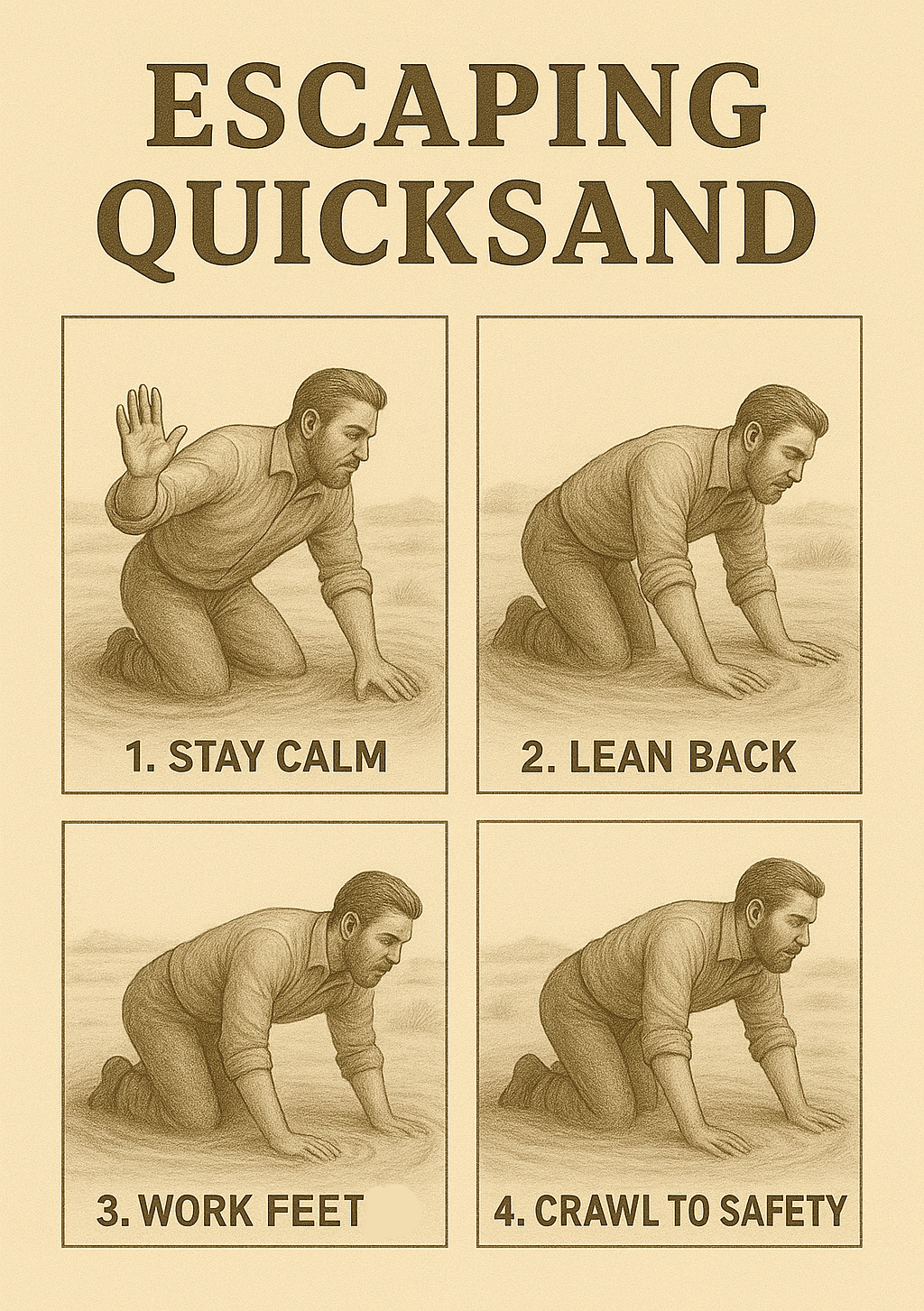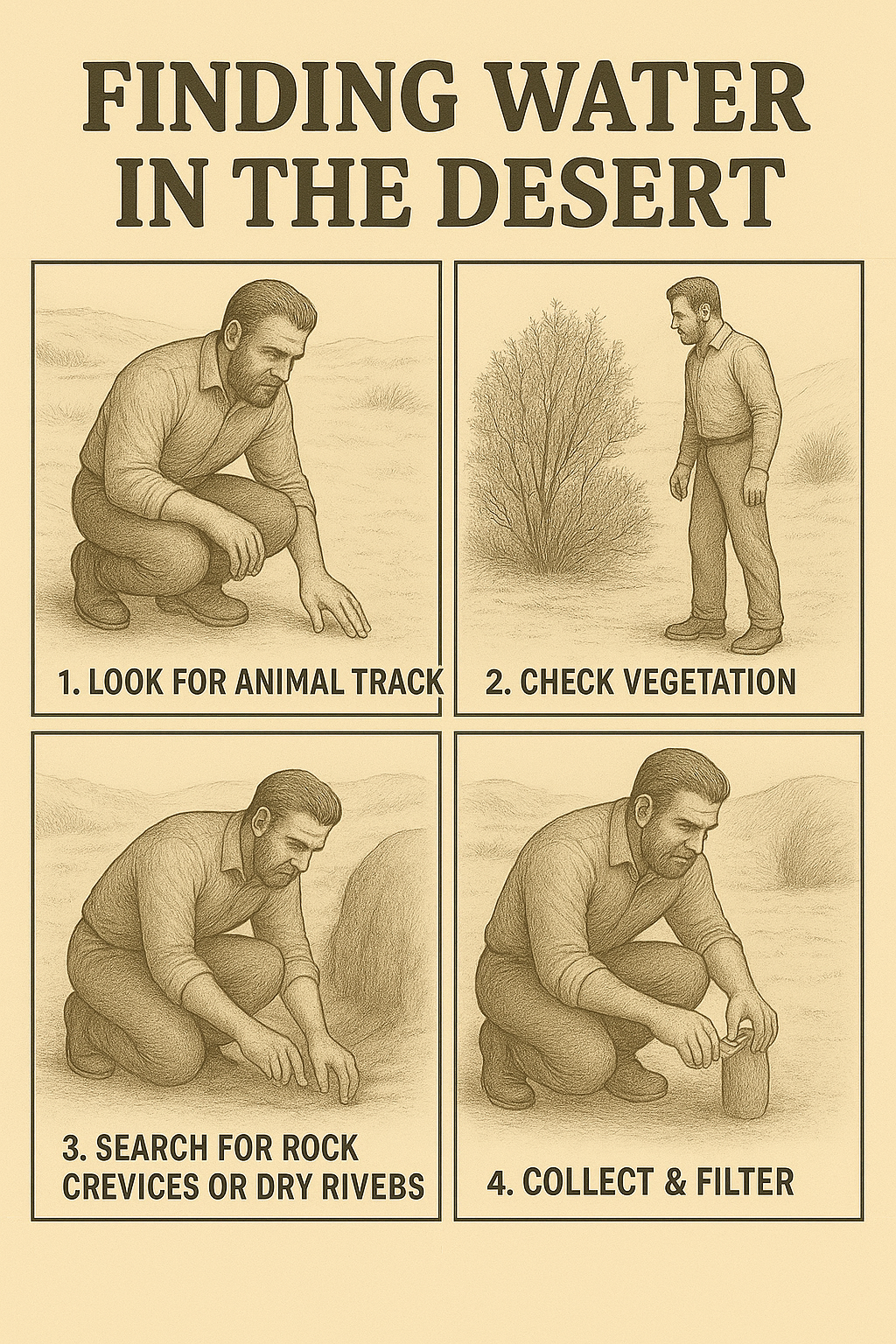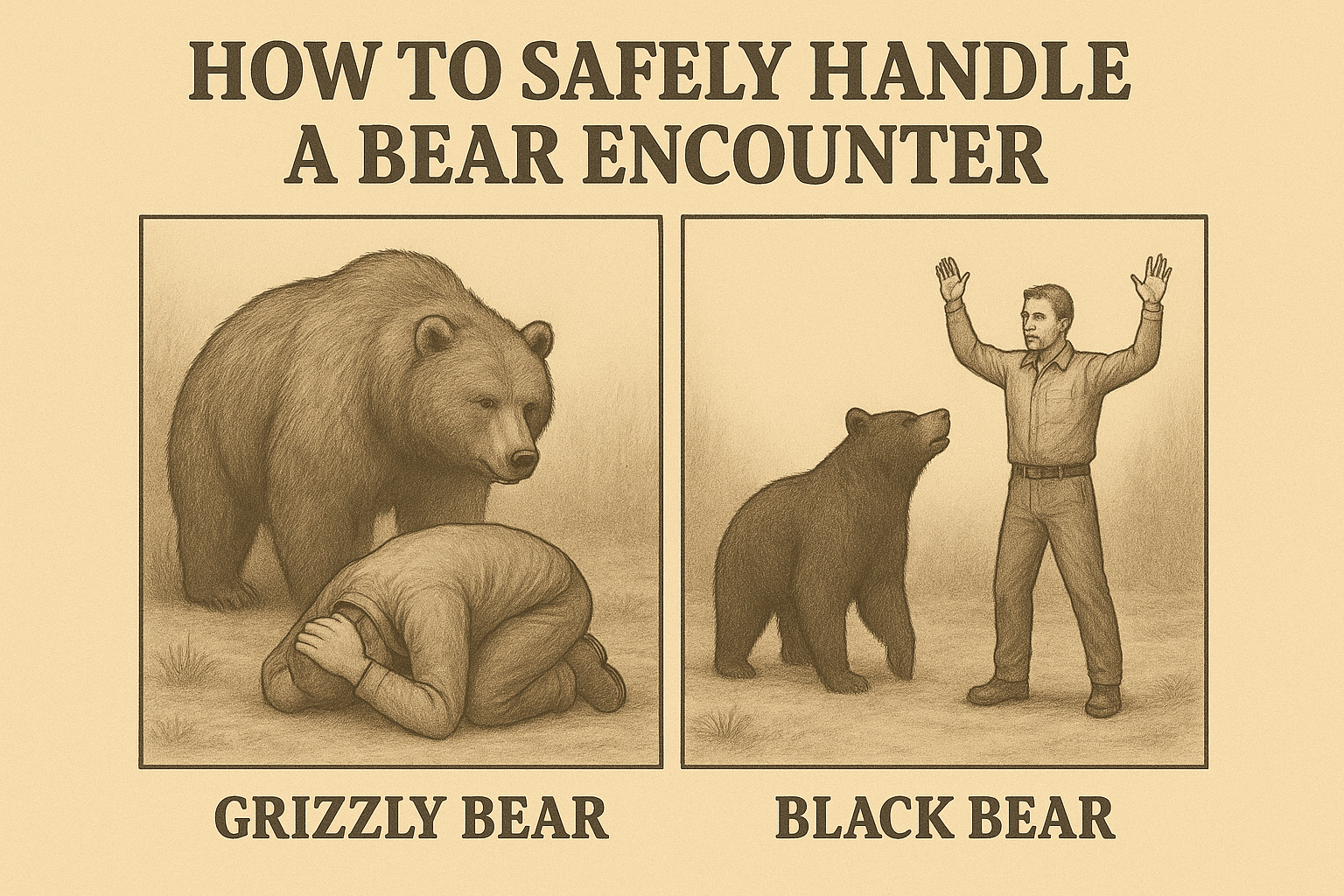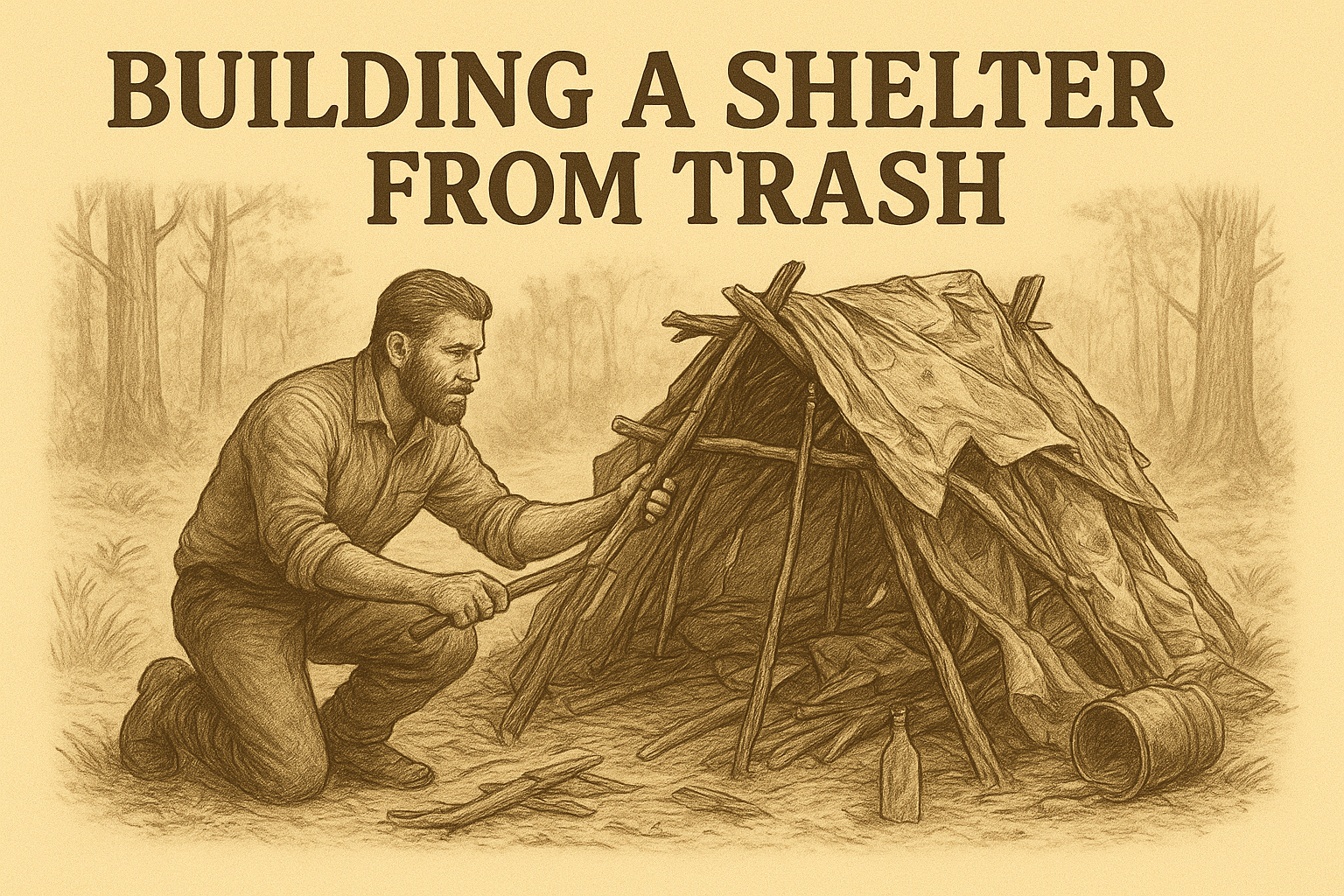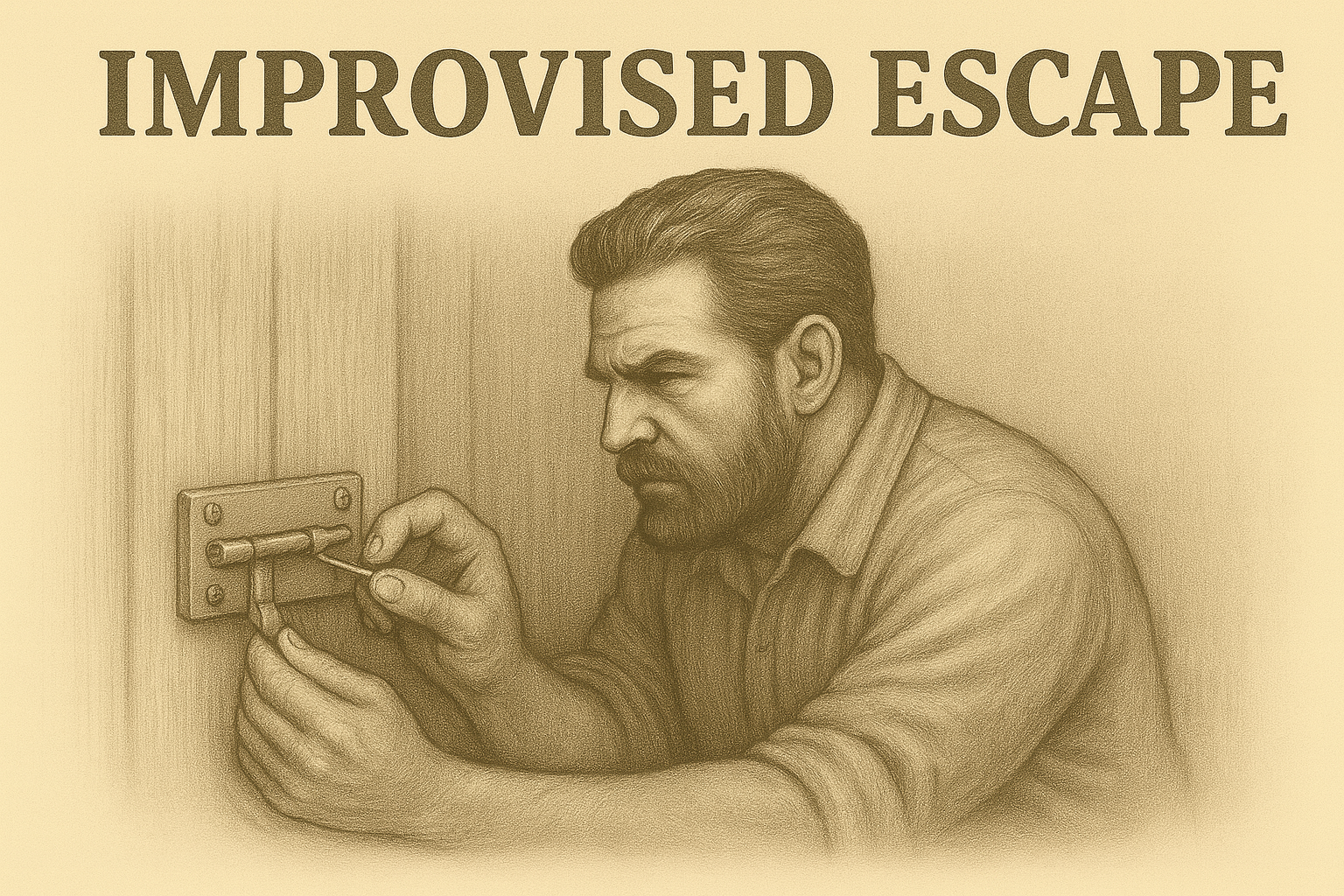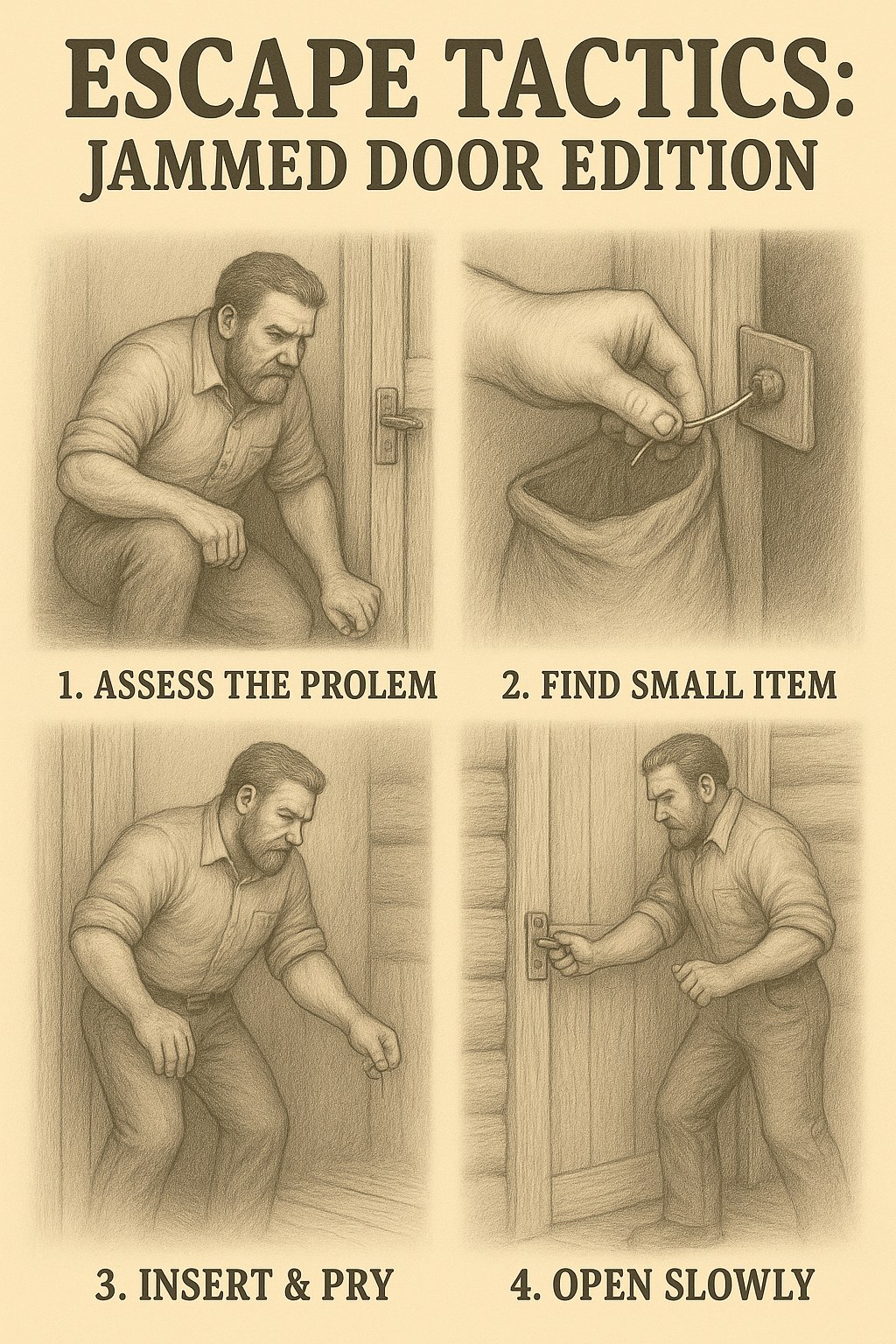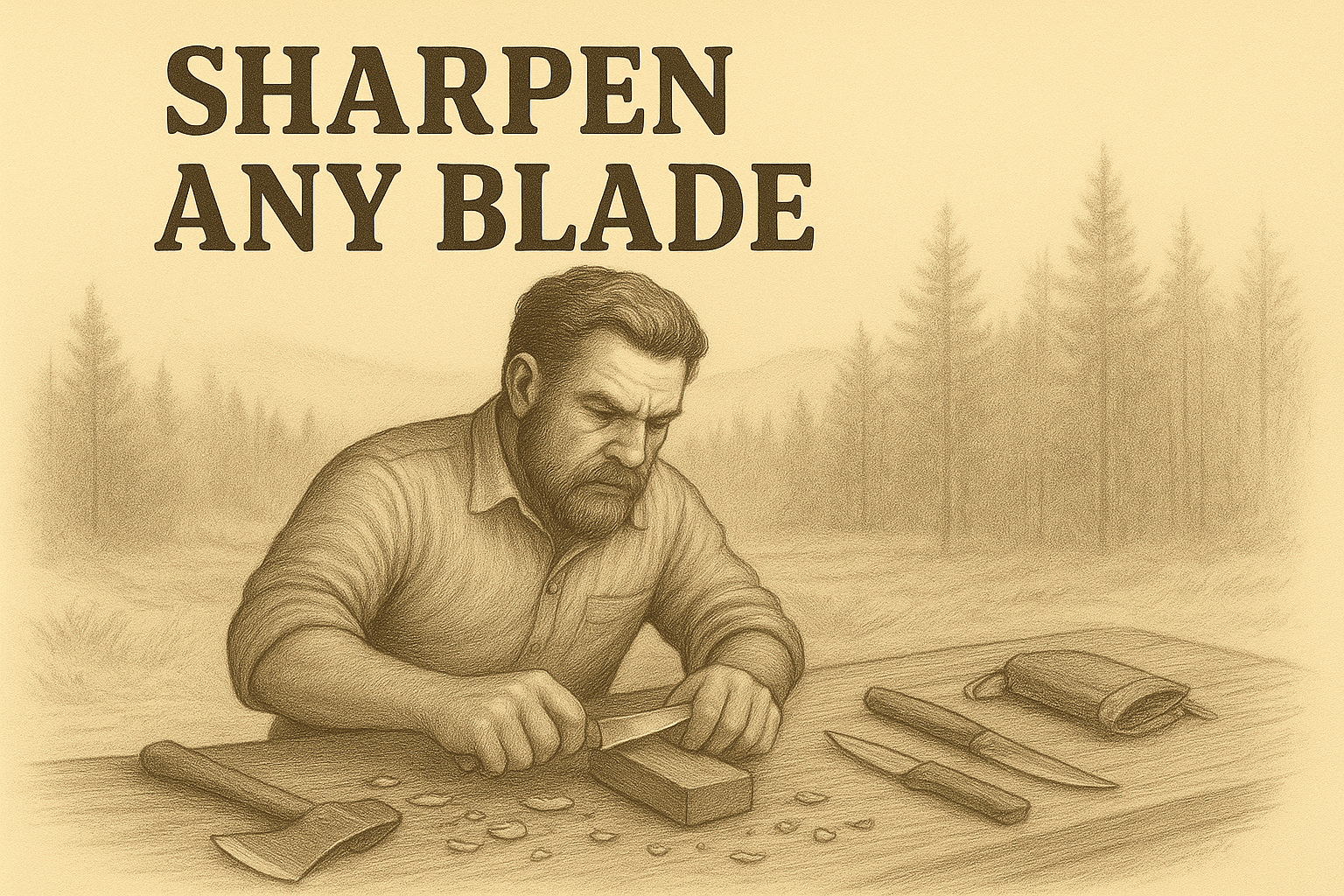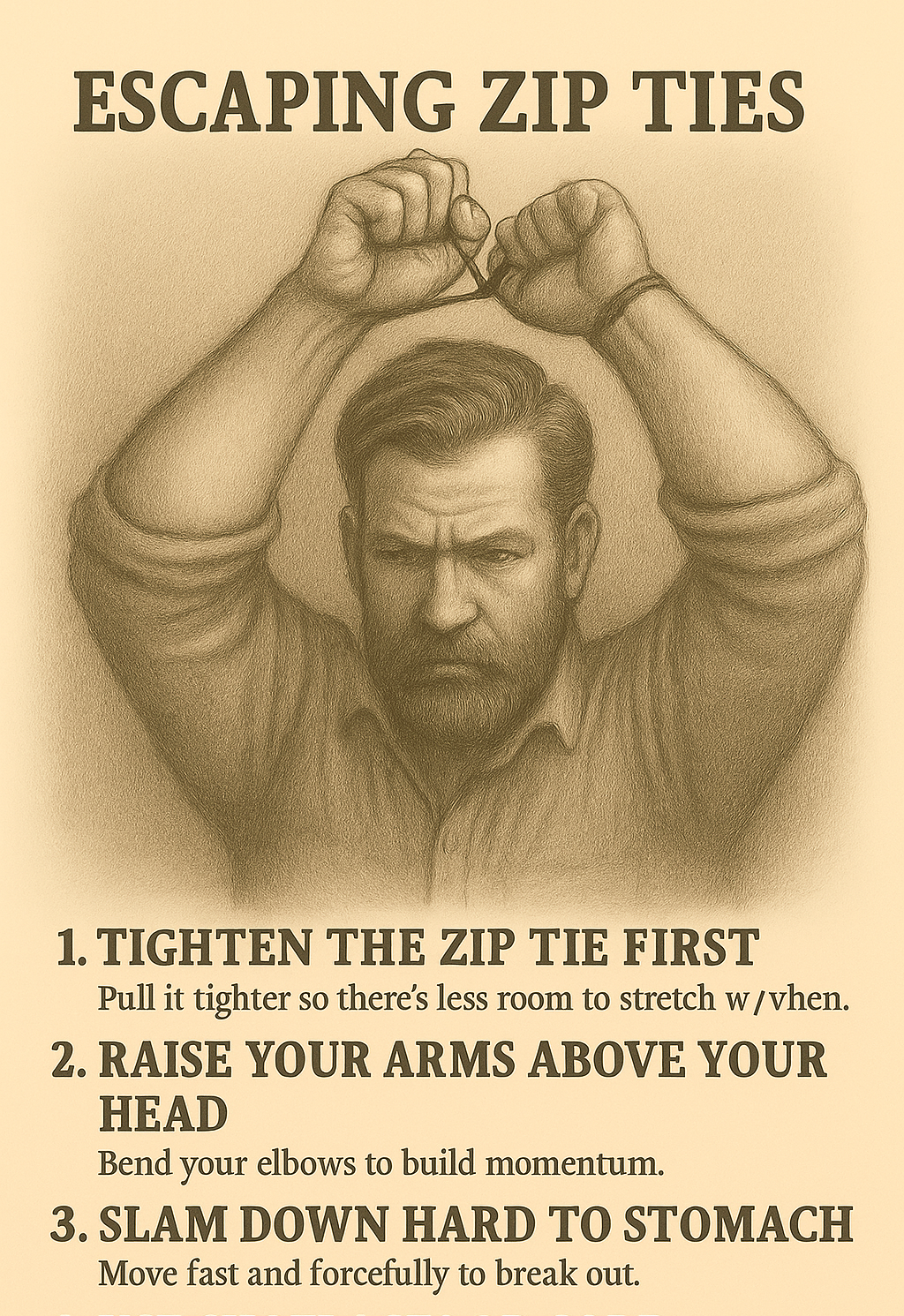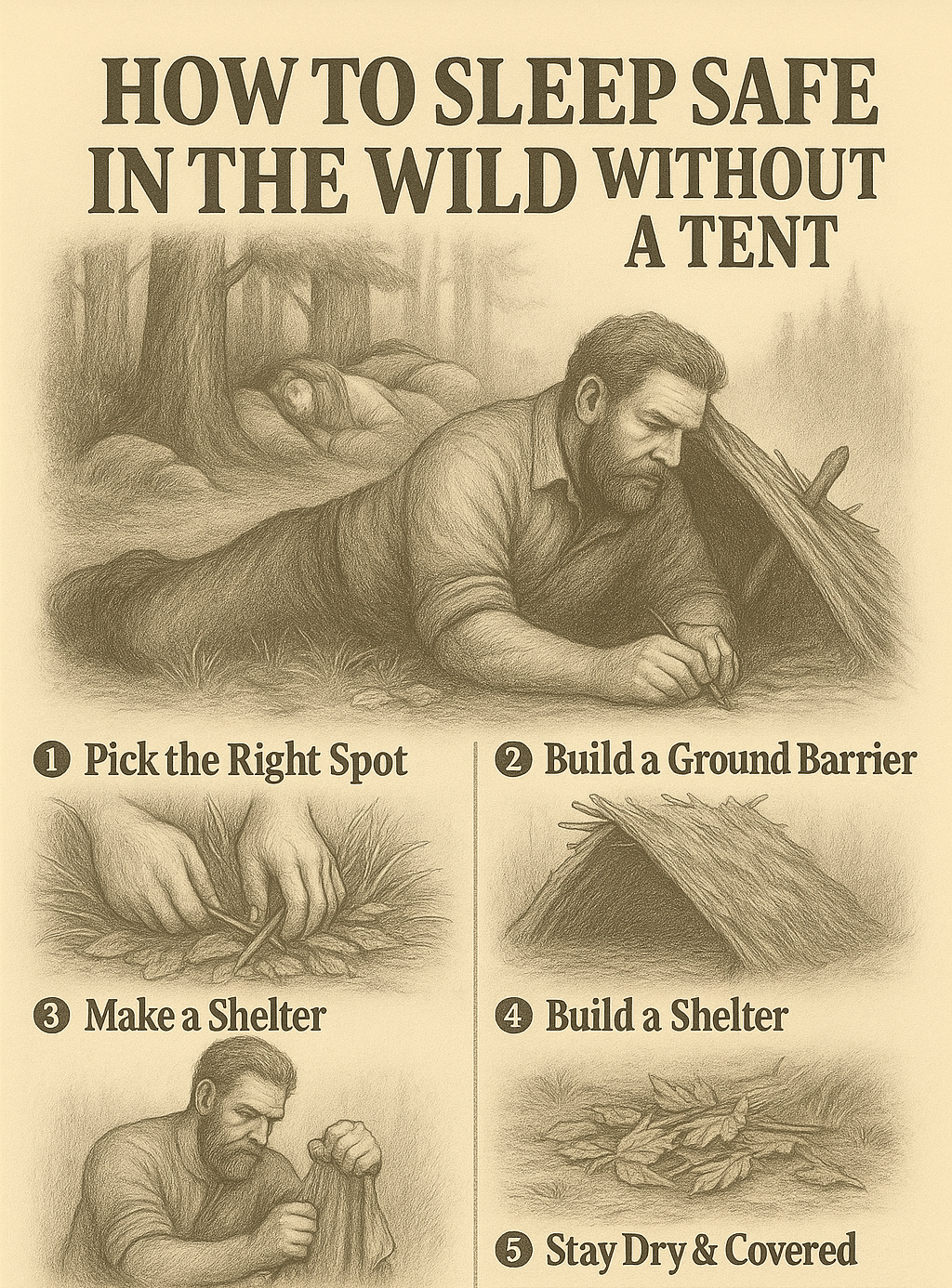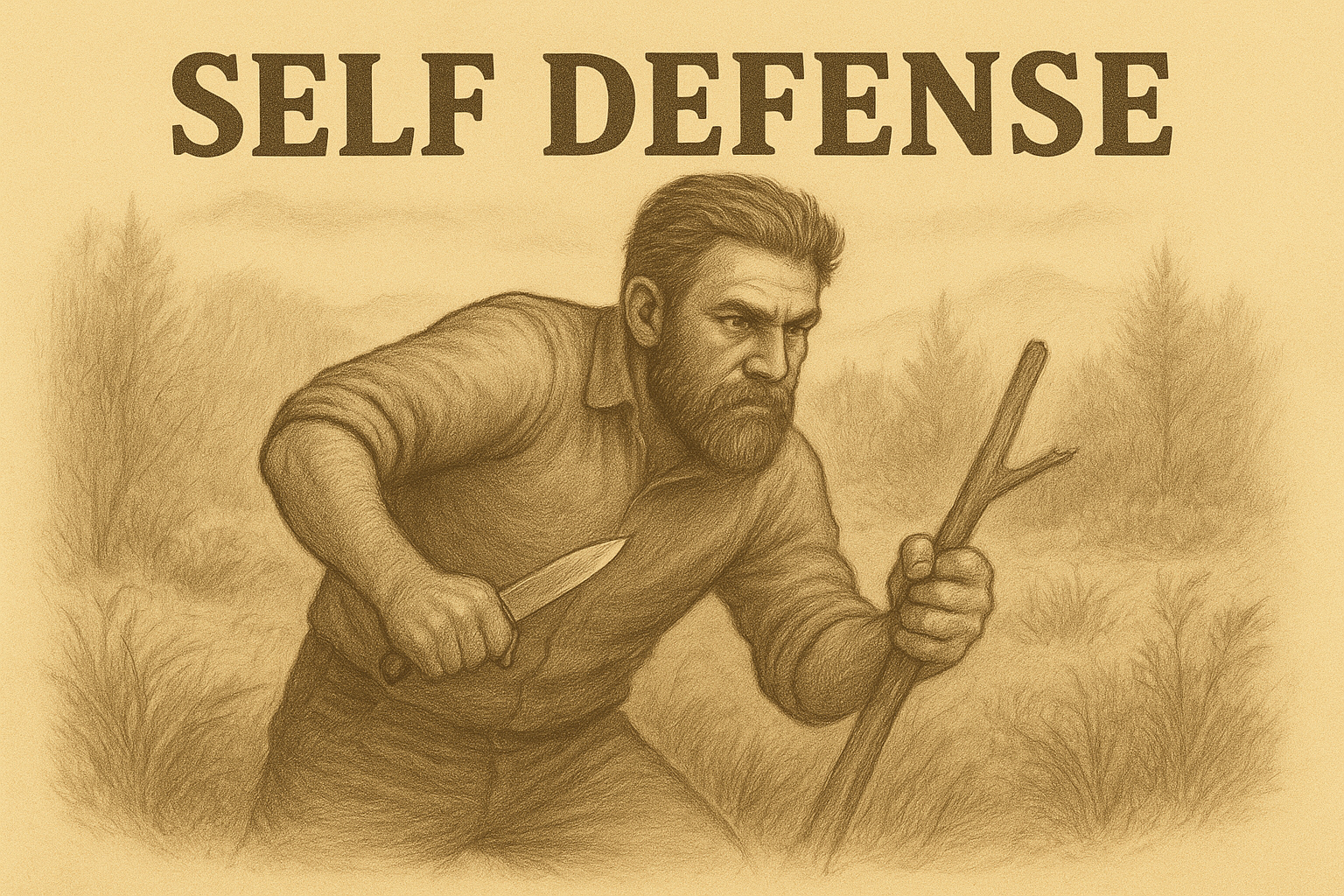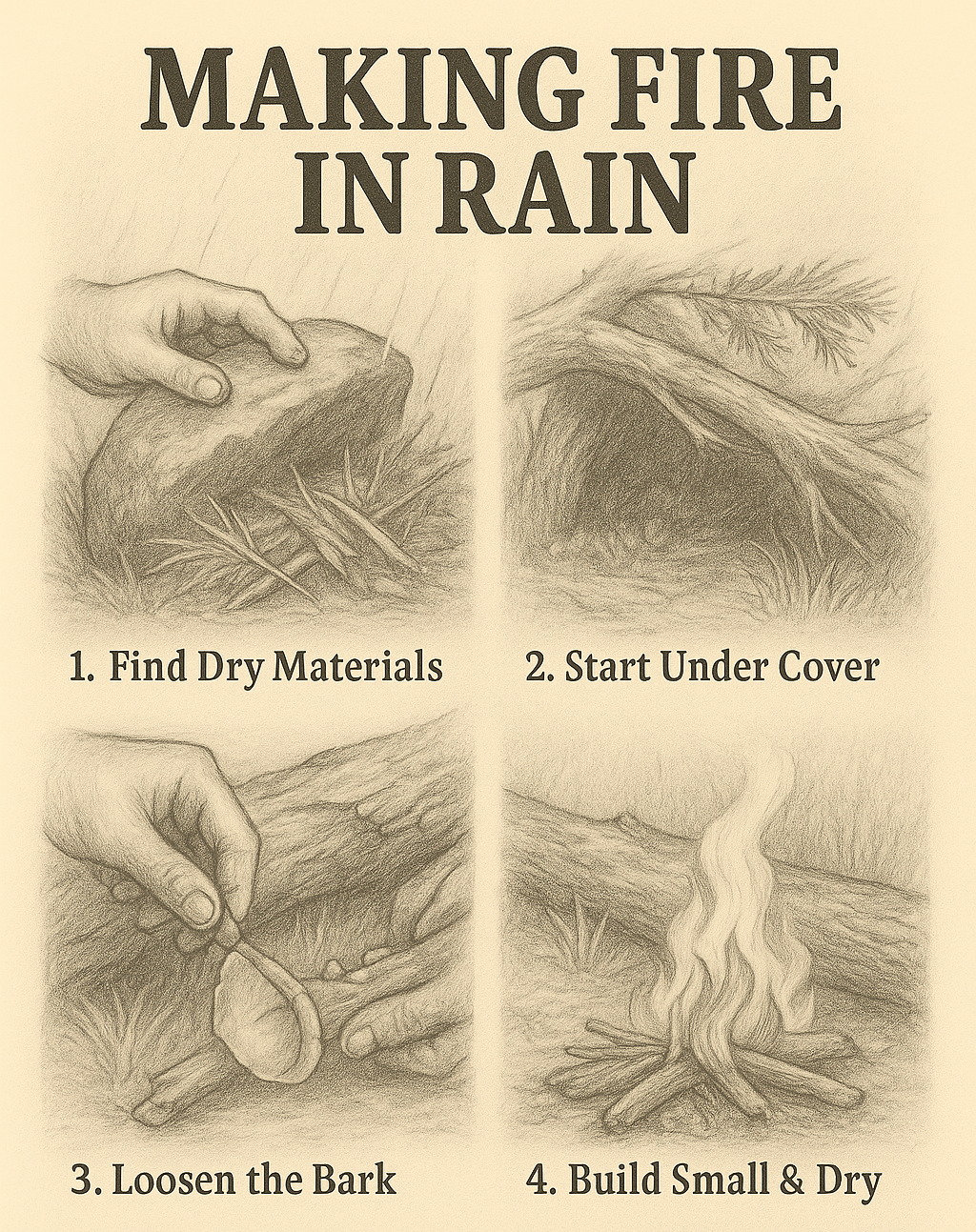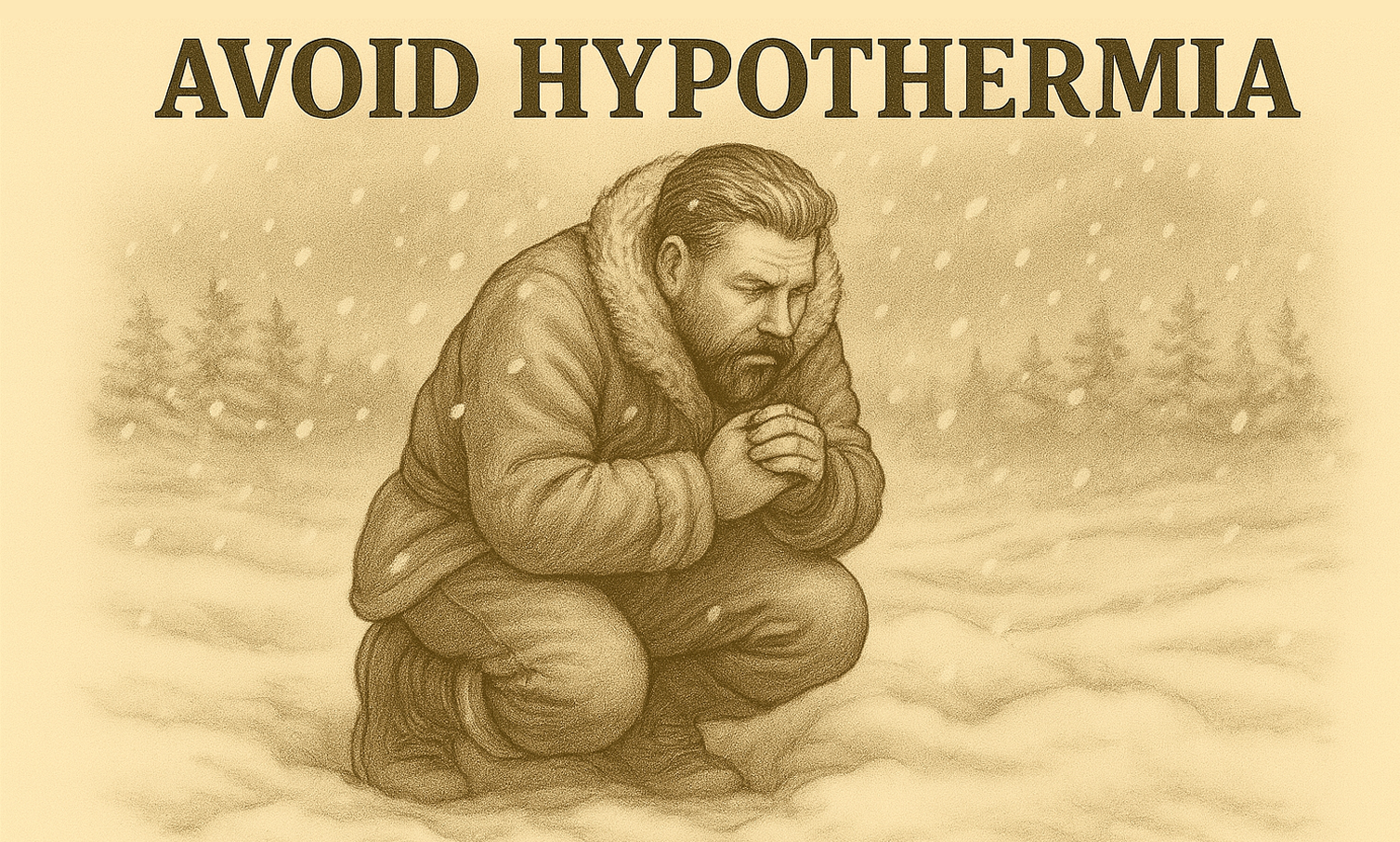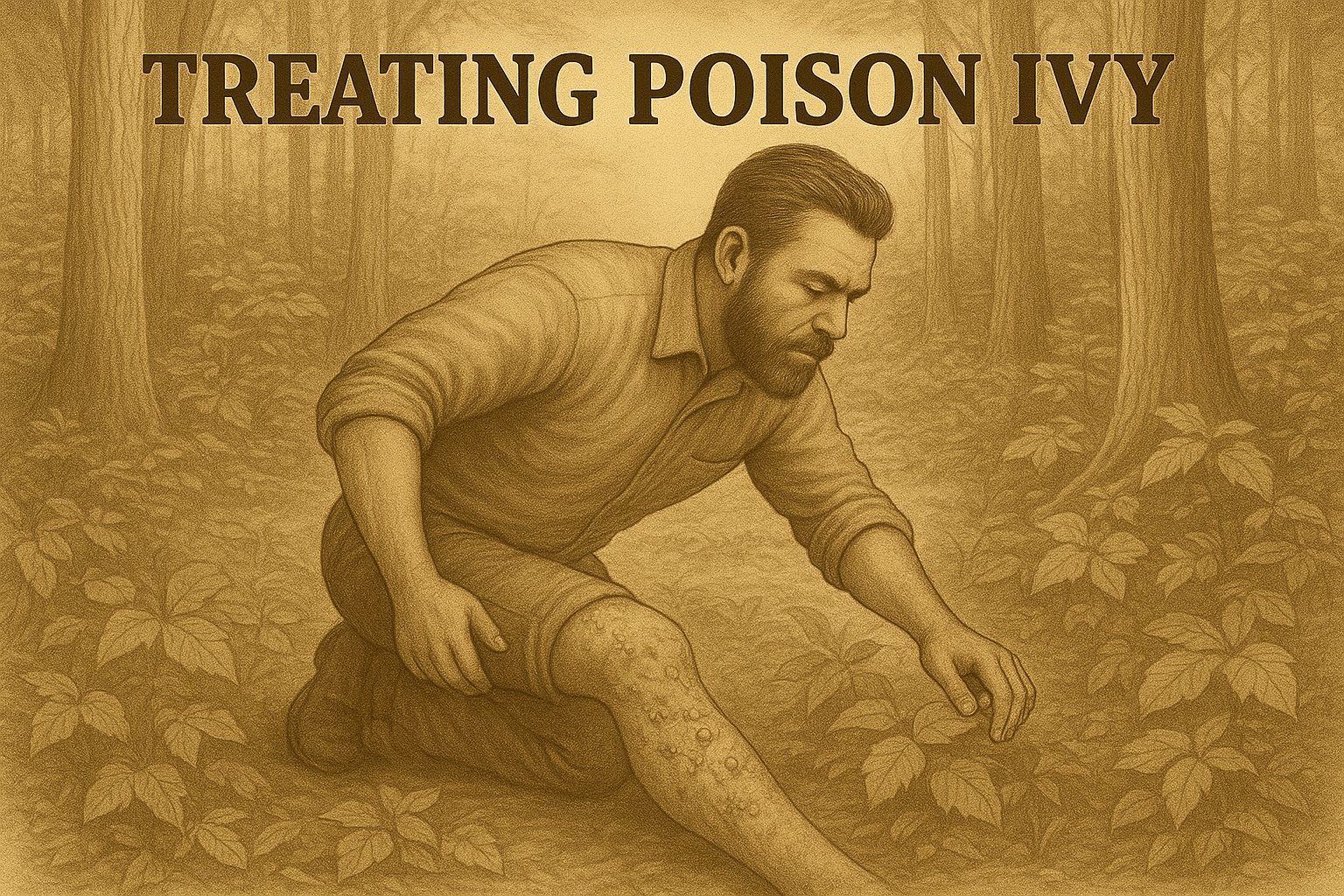Day 65: How to Escape Quicksand
Never stuck. Never still.
Quicksand isn’t just in the movies it’s real, and it can trap you fast. The more you fight, the deeper you sink. Survival comes down to staying calm and knowing the right moves.
What It Does
Stops panic before it kills you
Gets you free without wasting energy
Teaches control in high-stress survival moments
Turns a deadly trap into just another obstacle
How to Do It
1. Don’t Panic
Thrashing pulls you deeper. Breathe slow, stay calm, and fight the urge to struggle.
2. Lean Back
Spread your arms and lean onto your back. This increases surface area and keeps you afloat.
3. Move Slowly
Shift one leg at a time. Wiggle it gently side to side to create space, then slowly pull it out.
4. Float & Crawl
Once you free your legs, float on your back and crawl slowly toward solid ground — don’t lunge forward.
5. Use a Stick (If You Have One)
A long branch or trekking pole can distribute your weight and help you push free.
Tips
Quicksand is usually near riverbanks, marshes, or tidal flats. Step carefully in these areas.
Light, steady movements beat brute force.
Keep your pack if it helps you float — drop it only if it’s dragging you under.
Bottom Line
Quicksand looks terrifying, but it’s rarely deadly if you stay calm. Float, move slow, and think smart — panic is your real enemy.
step by step on how to escape QUICKSAND
Day 64: How to Find Water in the Desert
Calm crushes chaos.
When the desert sun is beating down, water isn’t just important it’s survival.
In dry lands, every drop counts. Knowing where to look could mean the difference between life and death.
What It Does
Keeps you alive in the harshest environment
Helps prevent heatstroke and dehydration
Turns barren land into a source of life
Buys you time to escape or get rescued
How to Do It
1. Follow the Green
Plants, even sparse ones, signal underground water. Look for shrubs, grasses, or palm like trees — roots often tap hidden sources.
2. Watch the Animals
Birds flying low at dawn/dusk, insect swarms, or animal tracks leading downhill often point toward water.
3. Collect Morning Dew
Before the sun rises, tie cloth or bandanas around your ankles and walk through grass or bushes. Wring them out for instant drinkable water.
4. Dig a Seep Hole
Find a low spot or dry riverbed. Dig down a couple of feet water often seeps in slowly. Filter or boil if you can.
5. Trap Condensation
Wrap leafy branches in a clear plastic bag, tie it shut, and leave in the sun. Evaporation will collect as droplets.
Tips
Move at night or early morning to conserve water.
Avoid drinking urine it speeds up dehydration.
Shade yourself to reduce sweating; water lost through sweat is survival fuel wasted.
Bottom Line
The desert looks empty, but water is there if you know how to find it. Master these tricks, and you turn the deadliest landscape into a livable one.
step by step: how to find water in the desert
Day 63: How to Handle a Bear Encounter
Earned, never given.
When it’s you and a bear, speed, noise, or panic can get you killed. The right response depends on the bear and your ability to stay calm.
What It Does
Reduces the chance of triggering an attack
Helps you identify the bear species fast
Keeps you alive until the bear leaves
Works in forests, mountains, or even campgrounds
How to Do It
Identify the Bear
Black Bear: Smaller, straight facial profile, taller ears.
Grizzly/Brown Bear: Large hump on shoulders, dish-shaped face.
Stay Calm, Don’t Run
Running triggers a chase instinct — you can’t outrun a bear.Talk Low and Move Slowly
Let the bear know you’re human. Speak in a calm, firm voice. Back away slowly, don’t turn your back.For Black Bears
If it charges, fight back with whatever you have — aim for the face and muzzle.
For Grizzly/Brown Bears
If it charges and makes contact, play dead. Lie flat or curl into a ball, cover your neck, and protect your stomach.
Make Yourself Big
Raise arms, jacket, or backpack to appear larger without making sudden moves.
Tips
Carry bear spray — it works on all bear species.
Avoid surprising a bear: make noise in thick brush or near rivers.
Store food away from camp and downwind.
Bottom Line
A bear encounter is about control — of your fear, your body language, and your movements. Read the bear right, and you both walk away.
step by step: on how to encounter a bear
Day 62: How to Build a Shelter From Trash
Slow is steady.
The Trash Shelter Trick
Stay Dry, Stay Alive with Street Scrap
When you’ve got no tent, no tarp, and the weather’s turning bad, you can still make a shelter from what everyone else throws away. It won’t win design awards, but it could save your life.
What It Does
Shields you from rain, wind, and cold
Insulates against the ground
Uses free, found materials anywhere
Keeps you alive until rescue or daylight
How to Do It
Scout for Structure
Look for pallets, large boxes, broken furniture, or doors to form walls.Insulate the Ground
Cardboard, rugs, or thick layers of plastic keep body heat from leaking into the earth.Wall It Up
Stack flattened boxes, tarp scraps, or sheet metal to block wind and hold heat.Top It Off
Use plastic sheets, roofing scraps, or layered cardboard as a roof.Lock It Down
Secure with wire, rope, duct tape — anything to keep the wind from tearing it apart.
Tips
Face the opening away from wind.
Layer materials for better insulation.
Keep it small — the less space inside, the warmer it will be.
Bottom Line
Trash can be worthless — or it can be the reason you make it through the night. The only difference is knowing how to use it.
step by step: build a shelter from trash
Day 61: how to stay warm with no fire
Stay calm always.
Skill: Stay Warm Without Fire
Fire’s great — but sometimes you can’t light one. Maybe it’s too wet, too windy, or too risky. Your body is a heat source. The trick is keeping that heat in.
What It Does
Keeps you warm without flames
Uses what you already have or can find
Works in rain, wind, or snow
How to Do It
Block the Wind
Get behind rocks, trees, or dig a small trench. Even a little windbreak can save body heat.Insulate Your Body
Stuff dry leaves, grass, or moss between layers of clothing. No gaps = less heat loss.Trap Your Heat
Zip your jacket all the way, cover your head, and tuck in your clothes. Your breath warms the space inside.Use the Ground
Cold ground sucks heat. Sit or lie on bark, branches, or your pack — anything to lift you off it.Generate Heat
Move slowly but steadily. Squats, push-ups, or just walking in place can raise your core temperature.
Tips
Wet clothes? Wring them out — even damp is better than dripping.
Keep your neck, head, and armpits covered — those lose heat fastest.
Avoid sweating — it chills you when you stop moving.
Bottom Line
No fire? No problem. Block the cold, trap your heat, and move smart. Your body is the furnace. Protect it.
step by step: stay warm with no fire
Day 60: How to start Fire with Foil & Battery
Earn every inch.
Skill: Fire from Everyday Items
Fire means warmth, light, safety, and the ability to cook. If you’ve got a battery and foil, you’ve got a flame.
What It Does
Ignites tinder without matches or a lighter
Uses items you already carry
Works fast — even in emergencies
How to Do It
Grab a Battery
AA, AAA, 9V anything small and charged.Find Foil
Gum wrapper foil works best. Tin foil works too ccut it into a thin strip.Shape the Strip
Make it into an hourglass shape (narrow in the middle). That’s where it’ll get hottest.Touch the Ends to the Battery
Hold one end to the positive terminal, the other to the negative.Light Tinder
The middle will glow and ignite. Touch it to dry grass, cotton, or bark shavings.
Tips
Prep your tinder before making the spark.
The foil burns fast be ready.
Practice it now so you’re fast when it counts.
Bottom Line
You don’t need matches to make fire just brains and a battery.
You have the power. Use it.
If you want a easy way to start a fire grab this hemp fire rope now<<
step by step: ignite fire with foil and battery
Day 59: How to Pick a Lock with Paperclips
Keep going. No matter.
Skill: Escape any locked door with a paperclip
When the lock clicks, freedom is seconds away — if you’ve got the skill. Paperclips can be more powerful than keys when you know what to do.
Why It Matters
• Bypass locked doors in emergencies
• Escape handcuffs or restraints
• Recover gear or shelter locked away
• Critical for urban survival & escape
What You Need
• 2 paperclips (metal, not plastic-coated)
• Pliers (optional but helpful)
• Patience and light touch
How to Do It
1. Turn Your Tools
Clip 1 = Tension Wrench
Bend into an L-shape. This will apply rotational pressure to the lock.Clip 2 = Pick
Unfold with a small hook at the end. This manipulates the pins.
2. Insert & Tension
Stick the L-shaped clip into the bottom of the keyhole.
Apply slight turning pressure — like you’re turning a key, but very gently.
3. Rake the Pins
Insert the pick at the top of the lock.
Gently lift and jiggle the pins while maintaining light tension with the wrench.
Feel for small “clicks” as each pin sets.
4. Twist to Unlock
Once all pins are set, the lock will turn.
Remove both clips and open the door or handcuff.
Tips
Practice on old locks to build skill.
Don’t force it — finesse wins.
Some locks are tougher than others. Stay calm.
Bottom Line
You don’t need keys when you understand locks.
This isn’t a party trick — it’s an escape plan.
Paperclips may just be your ticket to freedom.
Grab this 2200 lumen mini flashlight right now^^^^
step by step: pick a lock with a paperclip
Day 58: How to Sharpen Any Blade
Hunger builds champions.
Skill: A dull blade is dead weight. Sharp equals survival.
When your knife gets dull in the field, you don’t need a fancy sharpener. You just need to understand the edge — and how to bring it back to life.
What It Does
Keeps your blade cutting clean
Extends the life of your knife
Lets you process food, wood, or enemies without struggle
How to Sharpen in the Wild
1. Use a Flat Rock
Find a smooth river stone or flat piece of concrete. Wet it if possible. Hold your blade at a 20-degree angle and stroke evenly, one side then the other.
2. Ceramic Works Too
The bottom of a coffee mug or the edge of a ceramic tile has the grit to sharpen. Same angle, light pressure.
3. Strop with Leather or Belt
Drag the blade backwards (opposite sharpening direction) along a leather belt. It polishes and refines the edge.
4. Car Window Trick
Roll down your car window halfway. That exposed top edge of glass? It’s an emergency sharpener.
5. Nail File or Sandpaper
Fine grit works well. Fold it over a stick and use it like a sharpening rod.
Signs It’s Sharp
It cleanly slices paper or shaves hair
It bites into a thumbnail without slipping
It feels like it “catches” when dragged across skin (lightly!)
Tips
Always keep the sharpening angle consistent
Fewer strokes, more precision — don’t rush it
After sharpening, rinse and dry your blade to prevent rust
Bottom Line
A dull knife is dangerous. A sharp one? It’s power in your hand. When you know how to sharpen anything — you’re never unprepared.
This knife doesn’t need sharpening grab it above now^^^
step by step on how to sharpen any blade
Day 57: How to Camouflage While Hunting
Hide smart. Hunt smarter.
Skill: Vanish Without a Trace
When you’re hunting, movement kills the shot. But so does being seen.
Animals notice patterns, colors, shine, and sound — long before they notice you. This skill makes you disappear.
Why It Matters
Get closer without spooking game
Stay hidden from prey and predators
Blend into any terrain, with or without camo gear
How to Do It
1. Break Up Your Outline
Your human shape is easy to spot. Disrupt it. Use natural materials — leaves, branches, grass — to blur your silhouette. Don’t just wear camo; become part of the land.
2. Match the Environment
Dark woods? Go dark. Dry grass? Go light. Choose camo that mirrors the terrain. If you don’t have camo, rub dirt or ash on your clothes and skin. Use mud on exposed skin to dull shine.
3. Stay Still — Then Move Slow
Stillness is your strongest camouflage. When you move, go slow. Time your steps with wind, rustling trees, or other noise. Sudden motion is a dead giveaway.
4. Use Shadows
Stick to shaded areas. Shadows break light patterns and hide movement. Avoid walking on ridgelines or open areas where your body contrasts the sky.
5. Cover the Shine
Reflective gear, jewelry, glasses — even a clean knife — can flash light and alert prey. Matte everything out. Blacken with soot or dull with mud.
6. Watch the Wind
Your scent travels. Always move into the wind so your smell isn’t carried toward the animal. They’ll smell you before they see you.
Pro Tip
Animals watch for movement and pattern. Even the best camo fails if you’re bobbing your head or standing straight like a scarecrow.
Bottom Line
Camouflage isn’t just what you wear — it’s how you move, where you go, and how well you vanish. Become part of the wild and the wild won’t see you comi
When hunting during cold temperatures your body needs warmth to remain calm the heated vest is perfect for that grab it above.^^^
Step by step on how to camouflage
Day 56: How to Escape Zip Ties
Wrist locked. Mind loose.
Skill: Break Free Before It’s Too Late
If you ever find yourself restrained with zip ties — don’t panic. With the right technique, you can get out fast, even with your hands tied.
What It Does
Gets you out of unlawful restraints
Gives you a fighting chance to escape
Works even when you’re bound tightly
How to Do It
1. Tighten the Zip Tie First
It sounds wrong, but pulling your wrists tighter gives the tie less room to stretch — which makes it easier to break.
2. Raise Your Arms Above Your Head
Bend your elbows like you're about to throw down hard.
3. Slam Down Hard to Your Stomach
Use a fast, forceful motion. You’re not pulling apart — you’re snapping the plastic with sudden shock force.
4. Use Shoelaces or Cord (Optional Method)
Thread a shoelace through the tie, tie the ends to your shoes, and “bicycle” your legs — the friction will cut through.
Tips
Practice with dummy zip ties beforehand (safely).
Keep your arms close — leverage is key.
Don’t wait for a perfect moment. Break free fast and act.
Bottom Line
Zip ties are scary — but not unbreakable.
Master this one skill, and you’ll never feel helpless again.
grab this high quality medical go bag now^^^
Step by step on how to escape a zip tie
Day 55: How to Sleep Outside Without a Tent
Adapt fast. Last longer.
Skill: Rest Without Risk
Sleep keeps your mind sharp and your body strong. But in the wild, sleeping wrong can mean exposure, animals, or worse. Here’s how to rest safely — even with no tent, tarp, or gear.
What This Does:
Protects you from cold, bugs, and predators
Helps you wake up ready to move, fight, or survive
Keeps your gear and body dry and secure
Step 1: Pick the Right Spot
High. Dry. Hidden.
Avoid valleys where cold air settles.
Stay off trails — human or animal.
Choose flat ground with natural cover (rocks, trees, bushes).
Avoid creek beds — flash floods happen fast, even without rain nearby.
Step 2: Build a Ground Barrier
Insulate from below.
The cold ground will steal your heat.
Use what you’ve got:
Pine needles
Leaves
Branches
Dry grass
Layer thick. At least 4 inches deep.
Step 3: Build a Shelter
Keep heat in, water out.
No tent? No problem.
Lean sticks against a fallen log or rock wall
Weave in leaves, bark, branches
Add a "roof" layer for water runoff
Small space = warmer space
Even a basic debris hut can raise temps by 10–15°F inside.
Step 4: Stay Dry & Covered
Strip off wet clothes before bed
Wrap in anything dry (jacket, blanket, dry leaves)
Cover your head — most heat loss happens there
Keep gear close and under cover
Step 5: Set Alerts (Optional But Smart)
Place dry leaves or sticks around your camp
Set noise traps (rocks in cans, tripwires)
Sleep with your knife within reach
Bonus Tips:
Sleep on your back to preserve warmth
Don’t sleep too deep — light sleep is safer
Face your shelter entrance if possible
Warm a rock by the fire and wrap it in cloth near your core
Bottom Line:
You don’t need a tent to survive the night.
You need warmth, cover, and a bit of awareness.
The wild isn’t out to get you — but it doesn’t care if you’re ready or not.
Now you will be.
Although you now know how to sleep without a mattress doesnt mean you dont want one, grab one above^
step by step: how to sleep safe with no tent
Day 54: How to fight smart
Fear less. Know more.
Skill: Fight Smart, Survive Hard
Sometimes running isn’t an option. Out here, you don’t get to call 911. If someone—or something—comes at you, you better know how to respond fast, smart, and hard.
What It Does
• Helps you escape threats alive
• Buys time to retreat or regroup
• Turns fear into action
How to Defend Yourself
1. Stay Aware
Scan your surroundings. Look behind you. Listen for movement. Awareness is your first line of defense.
2. Use What’s Around You
Stick, rock, belt, pen—everything’s a weapon if you commit to using it. Your knife? Keep it close and ready.
3. Hit Where It Hurts
Eyes, throat, groin, knees. Go for pain. Go fast. One well-placed strike can end the fight.
4. Get Loud
Shout. Roar. Scream. It disorients attackers and shows you’re not an easy target.
5. Move With Purpose
Hesitate and you lose. Take a deep breath, then act. Strike and break contact fast.
Signs You’re In Danger
• Someone’s following or watching too long
• You feel cornered or blocked in
• They test your reaction with talk or touch
Tips
Keep your dominant hand free.
Practice drawing your blade under pressure.
Don’t fight fair—fight to escape.
Bottom Line
Out here, hesitation can cost you everything. Trust your instincts, strike smart, and always stay ready.
step by step on how to defend yourself
Day 53: How to Start a Fire in the Rain
Think ahead. Stay alive.
Skill: Lighting a Fire When Everything’s Wet
Rain makes fire-starting hard — but not impossible. You just need the right method, the right materials, and the mindset to make it happen.
What It Does
Gives you heat and light in cold, wet weather
Helps dry clothes and gear
Boosts morale and keeps predators away
How to Do It
1. Find Dry Tinder
Look under logs, tree bark, or deep inside your pack. Great options:
Birch bark
Fatwood (pine resin sticks)
Cotton balls with petroleum jelly
Dry grass or dryer lint (if packed)
2. Use a Wind Block
Find cover: a fallen tree, big rock, or tarp. Keep the rain and wind off your fire base.
3. Build a Platform
Lay down a base of bark or sticks to lift your fire off the wet ground.
4. Split the Wood
Even wet logs have dry cores. Use your knife or hatchet to split them and take the inside.
5. Start Small, Go Up
Light your dry tinder first. Then add pencil-thin sticks, then thumb-thick, then wrist-thick wood.
6. Add a Firestarter (If You Have One)
Ferro rod, waterproof matches, or a lighter — even in rain, they work with dry tinder.
Tips
Look for dead branches up off the ground — usually drier
Pine and cedar trees are gold mines for fire material
Keep your fire small and close — easier to shield from rain
Bottom Line
Rain doesn’t mean no fire. With the right prep and dry core wood, you can light a fire, stay warm, and stay alive.
Build smart. Burn hot. Stay dry.
step by step on how to start fire in the rain
Day 52: How to Avoid Hypothermia
Skills beat stuff.
Skill: Staying Warm = Staying Alive
Hypothermia can kill faster than hunger or thirst. It starts slow — shivering, confusion — then it takes over. Here’s how to stop it before it gets dangerous.
What It Does
Keeps your core temperature safe
Helps you think clearly and move fast
Stops you from freezing even without gear
How to Stop It
1. Stay Dry
Wet clothes steal heat. Change out of them fast. Dry off skin and layer up.
2. Block the Wind
Wind pulls warmth from your body. Use rocks, trees, shelters, or debris walls as a windbreak.
3. Insulate From the Ground
Cold ground drains body heat. Sit or sleep on leaves, pine boughs, bark — anything that lifts you off the dirt.
4. Layer Up
Use dry clothes, blankets, or even leaves under your shirt. More layers = more trapped heat.
5. Eat & Drink
Your body burns calories to stay warm. Eat something with fat, sugar, or protein. Stay hydrated — even cold water helps your system work.
6. Move Smart
Light exercise (like walking) creates heat. Don’t overdo it and sweat — that cools you down fast.
Signs You’re In Trouble
Shivering hard
Slurred speech
Confusion or clumsiness
Tired but can’t get warm
If you notice these, act now — don’t wait.
Tips
Wet socks are heat killers change them first.
If you can, build a fire or huddle with others.
If it’s raining, build a shelter before you get soaked.
Bottom Line
Hypothermia doesn’t look scary — until it’s too late. Stay dry, stay moving, and stay smart. Cold kills, but only if you let it.
If you ever are in a extremely cold survival situation the heated vest is perfect grab it above now^^^
Step by step on how to avoid hypothermia
Day 51: How to Keep Mosquitoes Off You in the Wild
Outlast. Outlearn. Outlive.
Skill: Staying Bite-Free Without Bug Spray
Mosquitoes don’t just bug you — they can carry disease, ruin your sleep, and drain your focus. Here’s how to keep them off using nothing but what you find in nature.
What It Does
Stops mosquitoes from biting
Lets you rest, move, and focus
Prevents itchy welts and infection
How to Stop Them
1. Cover Your Skin
Wear long sleeves, pants, and a hat — even in summer.
Go with light colors. Mosquitoes like dark.
2. Use Mud as a Shield
Rub a thin layer of mud on your skin.
Once it dries, mosquitoes won’t bite through it.
3. Burn Green Stuff
Add green leaves or pine needles to your fire.
Thick smoke drives bugs away.
4. Rub Natural Repellent
Crush cedar, pine, mint, or wild garlic and rub on your skin.
The scent helps repel mosquitoes.
5. Pick a Smart Camp Spot
Stay away from still water (mosquito breeding zones).
Camp where there’s a breeze and open space.
6. Smoke Your Shelter
Keep a smoky fire going near where you sleep.
It creates a bug barrier through the night.
Tips
Avoid resting at dawn or dusk — that’s when they swarm.
Keep moving if they start to gather.
Make your shelter tight or smoky to stay protected.
Bottom Line
Mosquitoes can ruin your survival mindset fast.
Use what’s around you — smoke, mud, plants — and you’ll stay bite-free, calm, and clear-headed.
step by STEP ON how to REPEL MOSQUITOES
Day 50: How to Treat Poison Ivy
Panic kills. Prep saves.
Skill: Curing the Itch Before It Spreads
Poison ivy and poison oak can wreck your survival focus. The oils from the plants cause painful rashes, blisters, and itching that can last for weeks. Here’s how to treat it fast and stop it from getting worse.
What It Does
✅ Soothes itching and pain
✅ Stops the rash from spreading
✅ Helps skin heal faster
How to Treat It
1. Wash Fast
Right after touching the plant, wash your skin with soap and cold water.
Do it within 30 minutes if you can. Cold water helps close your pores.
2. Remove Clothes
Take off anything that touched the plant (shirt, gloves, etc.).
Wash them separately so the oil doesn’t spread.
3. Apply a Treatment
Use one of these:
Crushed jewelweed (a natural anti-itch plant, often grows nearby)
Baking soda paste (mix with water and dab on rash)
Clay or mud (draws out oils and dries the rash)
Aloe vera or cool tea bags for calming the skin
4. Don’t Scratch
It spreads the rash and slows healing. If it blisters, don’t pop them.
5. Stay Cool & Dry
Heat and sweat make the rash worse. Stay in shade, wear loose clothes.
Tips
Poison ivy: “Leaves of three, let it be.”
Poison oak: Grows in groups of three or five leaflets
Don’t burn these plants — the smoke can poison your lungs.
Bottom Line
A poison rash in the wild can get bad fast.
Act early, treat it right, and keep your hands off it.
You’ll stay sharp, mobile, and ready to move.
if you are curing poison ivy a medkit couldn’t hurt grab it above^^^
step by STEP ON how to cure poison ivy
Day 49: How to Tell If a Plant Is Poisonous
Practice now. Survive later.
Skill: Use the Universal Edibility Test
In the wild, not every green thing is safe. Some plants can make you sick — or worse. But if you have no food, this test can help you tell what's safe to eat.
What It Does
Helps you avoid poisonous plants
Shows if a plant is safe to eat
Works with leaves, roots, or berries
Keeps you alive when you're out of food
How to Do It (Step by Step)
Only test one part of a plant at a time — leaf, stem, root, or fruit. Never eat mushrooms with this test.
1. Smell It
If it smells bad or like chemicals, skip it.
2. Touch It to Your Skin
Rub a small piece on your wrist or inside your elbow. Wait 15 minutes. If it burns or itches — don’t eat it.
3. Touch It to Your Lips
If your skin’s fine, press the plant to your lips. Wait 15 minutes. Any tingling? Spit it out.
4. Chew and Spit
If no reaction, chew a small bite. Don’t swallow. Wait 15 minutes. If you feel sick, stop.
5. Swallow a Tiny Bite
If everything feels okay, swallow a small piece. Wait a few hours. Still okay? Then it’s likely safe.
Tips
Never eat plants with milky sap, three shiny leaves, or bright purple berries
Boil plants if you can — it removes some toxins
If you feel sick at any step, stop immediately
Bottom Line
This test takes time — but it can save your life.
When in doubt, leave it out.
If you are testing plants for poison you need a medkit by this one is perfect grab it above now
step by step: how to see if a plant has poison
Day 48: How to Trap Small Animals
Earn every edge.
The Skill: Catch food with a basic snare
If you're hungry and can't hunt, a trap can do the work for you. It's quiet, easy, and doesn’t need gear.
What It Does
Helps you catch rabbits, squirrels, or birds
Works while you sleep or build shelter
Made with string, wire, or a shoelace
No knife or tools needed
How to Do It
1. Find Signs of Animals
Look for tracks, droppings, or small paths through the grass.
2. Make a Loop
Take a string or wire and tie it into a circle. This is the trap. It should get tight when pulled.
3. Tie It to a Stick
Wrap the other end of the string to a strong stick or stake. Push it deep into the ground so it stays put.
4. Set the Trap
Place the loop right where animals walk. Use tiny sticks to hold the loop open, about 2 inches above the ground.
5. Wait
Leave it. When the animal walks through, it gets caught.
Tips
Set more than one trap
Hide your scent by rubbing dirt on your hands
Don’t trap where there are no tracks
Bottom Line
A simple snare can feed you when nothing else can.
It works while you rest. It’s smart survival.
This is a great EDC knife built for a gentleman grab it above^^
step by step on how to make a animal trap
Day 47: how to deal with being bit by a snake
Ready beats lucky
Skill: Stay Calm. Act Fast. Know the Truth.
Snake bites can be scary but most aren’t deadly. What you do next can save your life.
Why It Matters
Some snakes have venom that can kill or make you very sick
Acting wrong makes things worse
Acting smart gives you the best chance
What to Do Right Away
1. Stay Calm
The more your heart pumps, the faster venom spreads.
Sit or lie down and take deep breaths.
2. Keep the Bite Low
Keep the bite below your heart.
Don’t lift your arm or leg if that’s where the bite is.
3. Don’t Move
Try to stay still.
Movement spreads venom faster.
4. Take Off Tight Things
Remove rings, bracelets, or watches near the bite.
It may swell fast.
5. Call for Help
If you have a phone or radio, use it now.
Say your name, where you are, and that you were bitten by a snake.
What NOT to Do
❌ Don’t suck out the venom
❌ Don’t cut the bite open
❌ Don’t use a tourniquet (it can cause more damage)
❌ Don’t drink alcohol or caffeine (they speed up your heart)
How to Know If It’s Venomous
Not all bites inject venom — and not all snakes have it.
But signs of venom include:
Fast swelling
Pain that gets worse
Feeling dizzy or sick
Trouble breathing (rare, but serious)
Tips
Learn what snakes live near you
Don’t step over logs or reach into holes blindly
Watch your step in tall grass
Bottom Line
If bitten, stay calm, stay still, and get help.
Don’t believe the old tricks — they can do more harm than good.
Smart thinking saves lives.
step by step on what to do if bit by a snake
Day 46: How to Track Animals in the wild
Suffer now. Survive later.
Skill: Follow Animals by What They Leave Behind
Tracking animals helps you find food or stay away from danger. You don’t need gear — just your eyes and a little patience.
Why It Matters
Helps you find animals to hunt
Keeps you safe from predators
Shows you where animals go
Helps you learn the land
How to Do It
1. Look for Footprints
Animals leave tracks in mud, dirt, sand, or snow.
Each animal has its own shape.
Deer tracks look like a heart
Bears have wide feet with 5 toes and claw marks
Coyotes or wolves have 4 toes and claws
Mountain lions have round prints with no claws showing
2. Find dung (Animal Poop)
Yes, poop matters.
Meat-eaters leave dark poop with fur or bones
Plant-eaters leave lighter poop with grass or leaves
3. Look Around You
Bent grass or broken branches show where an animal walked
Smooth paths in the dirt mean animals come through often
4. Look for Food Signs
Bitten leaves, dug-up roots, or scratched trees mean an animal ate there
5. Check How Fresh the Sign Is
Sharp, clean tracks = recent
Blurry or filled-in tracks = old
Wet poop = recent
Dry poop = old
Tips
Walk slowly and stay quiet
Look for tracks early in the morning
Always look where the animal might be going
Bottom Line
Animals leave clues. If you can follow them, you’ll find food or stay safe. Tracking is one of the best survival skills there is.




